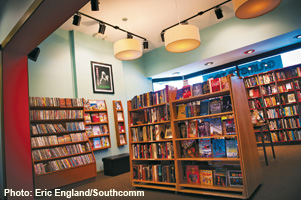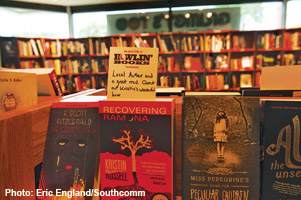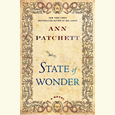Rockin’ Reads
Howlin’ Books in Nashville makes room on the shelf for music books and more
Howlin’ Books at Grimey’s Too is the brainchild of bookseller Gwil Owen and bookkeeper Jessica Kimbrough, who saw an under-served audience among Nashville’s readers. In the three months since the store opened, Howlin’ has become ground zero for the city’s bohemian literary set—post-hippies, neo-Beats—and the next generation of Kurt Vonnegut fans couldn’t be happier.
Jessica Kimbrough has been behind the scenes doing the books at Grimey’s for more than a decade. Over the years she’s also crunched numbers for local businesses like Frothy Monkey and Burger Up. Her Grimey’s co-owner, Gwil Owen, is an Academy-Award-nominated songwriter whose successful online bookstore, Turgid Tomes, now supports a family of four.
 “When Borders closed and Davis-Kidd was sold, I was like every other Nashvillian,” says Kimbrough. “I was like ‘Where am I going to buy books?’” After the initial panic, she quickly made a plan: “I called up Gwil and asked, ‘What if we opened a bookstore?’” Inspired by the possibilities, they began brainstorming about inventory, locations, and store names. Then they discovered they weren’t the only desperate readers in the city. “When Parnassus announced that they’d be opening, we realized that we wouldn’t have their budget or the Ann Patchett name,” says Kimbrough. “We knew we’d need to have a different angle, and we began to think, ‘Well, what if we had a ‘music’ bookstore?’”
“When Borders closed and Davis-Kidd was sold, I was like every other Nashvillian,” says Kimbrough. “I was like ‘Where am I going to buy books?’” After the initial panic, she quickly made a plan: “I called up Gwil and asked, ‘What if we opened a bookstore?’” Inspired by the possibilities, they began brainstorming about inventory, locations, and store names. Then they discovered they weren’t the only desperate readers in the city. “When Parnassus announced that they’d be opening, we realized that we wouldn’t have their budget or the Ann Patchett name,” says Kimbrough. “We knew we’d need to have a different angle, and we began to think, ‘Well, what if we had a ‘music’ bookstore?’”
Howlin’ found a natural home at Grimey’s Too. When their Remix Furniture neighbors moved out, Grimey’s wanted to expand, but the extra space was more than they needed, says Kimbrough. “So we started talking about sharing. We needed another partner, so I talked to Frothy Monkey, and it didn’t take long for them to come on board.”
But it’s the volumes on the shelves that really define a bookstore, and although Howlin’ is a bookstore in a record shop next to a coffee counter, it defines its own space with an open-feeling arrangement of shelves spanning several rooms that encourage engaged browsing. “Before we even had a location, back when we’d just come up with the name Howlin’ Books, Gwil started collecting,” says Kimbrough. “When he looks at books he chooses really carefully. They have to look a certain way. They have to have a certain condition, and they also have to have that cool factor.”
The centerpiece of Howlin’ is a monolithic stack of shelves at the front of the store known as the Wall of Sound. It’s jammed with books about bands, songwriters, genres, eras, and stars. A quick browse of the Wall includes highlights like Levon Helm’s memoir This Wheel’s on Fire, three full shelves of Bob Dylan books, more than a dozen titles from Bloomsbury Academic’s acclaimed 33 1/3 series of album criticism, and Nick Tosches’s seminal studies of rock’s roots: Country and Unsung Heroes of Rock ‘n’ Roll.
But despite the incessant, infectious Smokey Robinson soundtrack the store’s staff was spinning when I visited, and the sheer mass of the Wall of Sound, it’s misleading to call Howlin’ a “music” bookstore. It’s more accurate to think of it as a place that sells “books that rock” and all that “rock” may imply. Yes, there are books about rock, jazz, blues, folk, and country music, but there are also books about the counter-cultural people, events, attitudes, politics, art, and fashions that rock has always aided and abetted. In addition to blues legend Howlin’ Wolf, the store’s name recalls poet Allen Ginsberg’s taboo-breaking epic poem “Howl.”
In keeping with that aesthetic, the store’s offerings are full of sex, drugs, roused rabbles, inspired artists, and bohemians of all sorts. “When we first opened, we had this really groovy fiction section,” says Kimbrough. “The books we had on opening day were just incredible, but whole sections are gone now. Opening weekend we sold every Tom Robbins title we had. We can’t keep Kurt Vonnegut in stock. We can’t keep Ray Bradbury in stock.” Current bestselling books at the store include titles like the six-month-old Willie Nelson memoir, Roll Me Up and Smoke Me When I Die, as well as the timeless Patti Smith memoir, Just Kids. “We can’t keep that one on the shelves,” says Kimbrough. “As soon as we get more, they vanish.”
 She also mentions Joan Didion’s first essay collection, Slouching Towards Bethlehem, as a staff favorite. The book evokes California in the 1960s, and Didion’s observations on the birth of contemporary American counter-culture reflect much of what makes Howlin’s selections feel like a carefully curated whole and not just a bunch of used books. In the literature section, Anaïs Nin titles like A Spy in the House of Love and Seduction of the Minotaur are decorated with lovely vintage designs while a long-haired, wiry, young Thomas McGuane glowers from the front of a paperback copy of his 1969 debut novel The Sporting Club, the yellow-to-red color bleeding across the cover like the sunburst on a Fender Telecaster. In the film section, a critical classic like Francois Truffaut’s Hitchcock shares shelf space with the life story of porn star Ron Jeremy and a memoir by blacksploitation queen Pam Grier. The store seems haunted by the Beat Generation writers and their acolytes.
She also mentions Joan Didion’s first essay collection, Slouching Towards Bethlehem, as a staff favorite. The book evokes California in the 1960s, and Didion’s observations on the birth of contemporary American counter-culture reflect much of what makes Howlin’s selections feel like a carefully curated whole and not just a bunch of used books. In the literature section, Anaïs Nin titles like A Spy in the House of Love and Seduction of the Minotaur are decorated with lovely vintage designs while a long-haired, wiry, young Thomas McGuane glowers from the front of a paperback copy of his 1969 debut novel The Sporting Club, the yellow-to-red color bleeding across the cover like the sunburst on a Fender Telecaster. In the film section, a critical classic like Francois Truffaut’s Hitchcock shares shelf space with the life story of porn star Ron Jeremy and a memoir by blacksploitation queen Pam Grier. The store seems haunted by the Beat Generation writers and their acolytes.
Beyond nostalgia, the books Gwil Owen chooses have become American classics that act as important signposts for any young reader trying to understand where contemporary music, fashion, art, and film came from. The writings of Ginsberg, William S. Burroughs, and Henry Miller put an end to the kind of literary censorship that readers today would find unimaginable. Other books have become common rites of passage: who hasn’t read On the Road or Catcher in the Rye—or both—by the time they’ve reached their early 20s?
Howlin’s other resurgent authors might come as a surprise, however. “Who knew so many people still wanted to read Tom Robbins?” Kimbrough asks. “My daughter will be going to college next year, and she bought a big stack of Vonnegut and a big stack of Allen Ginsberg,” says Kimbrough. “She told me that this summer, before school, she’s gonna read all the stuff that everybody says is cool.”
At only a few months old, the store continues to evolve. Howlin’ has hired a local carpenter to build more shelves. The handsome pieces roll on casters to make room for author signings, readings, and—of course—musical performances. Kimbrough and Owen plan to dress up the space with more formal signage, and there are even whispers of a possible beer license for the Frothy Monkey space. “I’m having a great time,” says Kimbrough. “It couldn’t be more fun.”
By the time our interview ended, the Smokey Robinson soundtrack had broken into Tom Waits’s version of the Sondheim/Bernstein classic “Somewhere” from West Side Story:
There’s a place for us,
Somewhere, a place for us.
I think I know just the spot.
Howlin’ Books is at 1702 8th Avenue South in Nashville.


